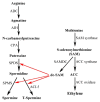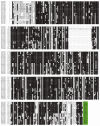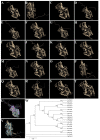Polyamine Oxidases Play Various Roles in Plant Development and Abiotic Stress Tolerance
- PMID: 31234345
- PMCID: PMC6632040
- DOI: 10.3390/plants8060184
Polyamine Oxidases Play Various Roles in Plant Development and Abiotic Stress Tolerance
Abstract
Polyamines not only play roles in plant growth and development, but also adapt to environmental stresses. Polyamines can be oxidized by copper-containing diamine oxidases (CuAOs) and flavin-containing polyamine oxidases (PAOs). Two types of PAOs exist in the plant kingdom; one type catalyzes the back conversion (BC-type) pathway and the other catalyzes the terminal catabolism (TC-type) pathway. The catabolic features and biological functions of plant PAOs have been investigated in various plants in the past years. In this review, we focus on the advance of PAO studies in rice, Arabidopsis, and tomato, and other plant species.
Keywords: back conversion pathway; polyamine catabolism; polyamine oxidase; polyamines; stress response; terminal catabolism pathway.
Conflict of interest statement
The authors have no conflicts of interest to declare.
Figures





Similar articles
-
Copper-containing amine oxidases contribute to terminal polyamine oxidation in peroxisomes and apoplast of Arabidopsis thaliana.BMC Plant Biol. 2013 Aug 5;13:109. doi: 10.1186/1471-2229-13-109. BMC Plant Biol. 2013. PMID: 23915037 Free PMC article.
-
Polyamine Catabolism in Plants: A Universal Process With Diverse Functions.Front Plant Sci. 2019 May 7;10:561. doi: 10.3389/fpls.2019.00561. eCollection 2019. Front Plant Sci. 2019. PMID: 31134113 Free PMC article. Review.
-
Copper-Containing Amine Oxidases and FAD-Dependent Polyamine Oxidases Are Key Players in Plant Tissue Differentiation and Organ Development.Front Plant Sci. 2016 Jun 28;7:824. doi: 10.3389/fpls.2016.00824. eCollection 2016. Front Plant Sci. 2016. PMID: 27446096 Free PMC article. Review.
-
Expression profile of seven polyamine oxidase genes in rice (Oryza sativa) in response to abiotic stresses, phytohormones and polyamines.Physiol Mol Biol Plants. 2021 Jun;27(6):1353-1359. doi: 10.1007/s12298-021-01006-1. Epub 2021 May 28. Physiol Mol Biol Plants. 2021. PMID: 34220045 Free PMC article.
-
Plant Peroxisomal Polyamine Oxidase: A Ubiquitous Enzyme Involved in Abiotic Stress Tolerance.Plants (Basel). 2023 Feb 1;12(3):652. doi: 10.3390/plants12030652. Plants (Basel). 2023. PMID: 36771734 Free PMC article. Review.
Cited by
-
How Extracellular Reactive Oxygen Species Reach Their Intracellular Targets in Plants.Mol Cells. 2023 Jun 30;46(6):329-336. doi: 10.14348/molcells.2023.2158. Epub 2023 Feb 17. Mol Cells. 2023. PMID: 36799103 Free PMC article. Review.
-
Polyamine: A Potent Ameliorator for Plant Growth Response and Adaption to Abiotic Stresses Particularly the Ammonium Stress Antagonized by Urea.Front Plant Sci. 2022 Mar 23;13:783597. doi: 10.3389/fpls.2022.783597. eCollection 2022. Front Plant Sci. 2022. PMID: 35401587 Free PMC article. Review.
-
Plant Polyamines.Plants (Basel). 2020 Apr 16;9(4):511. doi: 10.3390/plants9040511. Plants (Basel). 2020. PMID: 32316095 Free PMC article.
-
Phenotypic and transcriptomic analysis reveals early stress responses in transgenic rice expressing Arabidopsis DREB1a.Plant Direct. 2022 Oct 19;6(10):e456. doi: 10.1002/pld3.456. eCollection 2022 Oct. Plant Direct. 2022. PMID: 36267847 Free PMC article.
-
Polyamine pathways interconnect with GABA metabolic processes to mediate the low-temperature response in plants.Front Plant Sci. 2022 Oct 20;13:1035414. doi: 10.3389/fpls.2022.1035414. eCollection 2022. Front Plant Sci. 2022. PMID: 36340403 Free PMC article. Review.
References
-
- Cohen S.S. A Guide to the Polyamines. Oxford University Press; New York, NY, USA: 1998.
Publication types
Grants and funding
LinkOut - more resources
Full Text Sources
Miscellaneous

